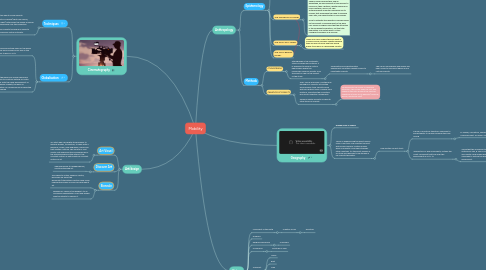
1. Cinematography
1.1. Techniques
1.1.1. Let's talk about Frame mobility: Mobility in framing (shot from above, crane shot) often gives the viewer a feeling of omniscience over the characters. Camera Mobility technique is linked to self-conscious virtual virtuosity.
1.1.1.1. Techniques such as SteadiCam and Louma Crane offer stabilty since the 1980s. Churchill said that even though the SteadiCam as practicality issues, it encourages innovation. However, the ability of Steadicam to rapidly change perspectives works wonderfully with quick-cutting creating excitement to viewers. Nonetheless, a whole new system appeared that offered remote-control mobility, eliminating the restriction of hands-on cameras. Basically, greater mobility
1.2. Globalisation
1.2.1. Hollywood’s percentage share of the global box office has increased from 60% in the late 1970s to 90% in 2014.
1.2.2. 72% of the global box office figures are attributed to countries outside of North America. With the rapid development of U.S. overseas markets, the pace of globalisation of Hollywood has accelerated and deepened
1.2.2.1. CASE STUDY: KUNG-FU PANDA
1.2.2.1.1. Kung Fu Panda is a symbol of this era of the Hollywood film industry. It successfully references and utilises a different traditional culture and corresponding national elements into its design and narrative. The architectural style of Kung Fu Panda is retro, with many cute characters and traditional Chinese clothing and diet elements penetrating every detail of the movie. This setting is attractive to Western audiences, and for the Oriental audience, they will feel excited as it is a Western movie.
2. Art/design
2.1. Art Visuel
2.1.1. An artist who uses digital technologies to express himself, to question, to seek; with a grammar, codes, new languages, issues and that defines a culture. The formula is a bit cryptic but addresses the consequences of the massive spread of the Internet: the constant motion of data creates a constant motion of art
2.2. Discover Art
2.2.1. Opening people to neighborhoods, countries through Art
2.3. Biennale
2.3.1. According to author Federica Martini, biennales are about the diplomatic/international relations and urban regeneration plans as much as being about art.
2.3.2. Biennale of Venise is the biggest. It's an incredible manifestation of art and people walk the streets to explore it.
3. Anthropology
3.1. Epistemology
3.1.1. THE MODEL OF GRAVITY
3.1.1.1. Ravenstein focuses on distance and dimension: - Any territory exerts a migratory attraction force according to the importance of its population. By example, 40% of the immigrants in metropolitan France live in Ile-de-France. - The attraction of a territory is proportional to the saying separating it from other territories: the number of migrants is all the more important as the distance is small.
3.1.1.1.1. It should be noted that the gravity model refers to migration in general, thus also to international migration. It helps to ascertain the intensity of certain migrations since it shows that individuals move as if attracted elsewhere by a force that decreases with distance.
3.1.2. THE OPPORTUNITY MODEL
3.1.2.1. People move because they find an advantage, an improvement in their access to resources, their lifestyles, greater physical or moral freedom, and so on. This anthropological reflection has given rise to models that emphasize the need to improve one's fate, job opportunities or life choices. How to estimate the migratory choices based on this pursuit of improvement of the daily life? Daniel Courgeau says that the attraction is the immigrant population, not the total population of a certain place. Future immigrants imagine an El Dorado
3.1.3. THE PUSH-PULL MODEL
3.1.3.1. Lewis and Harris Todaro theorize what is common sense: workers migrate because they are poor at home and they would prefer to be poor in a developed country.
3.1.4. THE COST-BENEFIT MODEL
3.2. Methods
3.2.1. ETHNOGRAPHY
3.2.1.1. Ethnography is the systematic study of people and cultures. It is designed to explore cultural phenomena where the researcher observes society from the point of view of the subject of the study.
3.2.1.1.1. Observational and participative experiments constitue insightful ways to investigate mobility
3.2.2. PARADIGM OF MOBILITY
3.2.2.1. Alain Tarrius proposed a "methodical paradigm of mobility" articulated around space-time-identity along with four distinct level of space-time relations, indicating the circulatory process of migration movements. Whereas spatial mobility is linked to other types of mobility
3.2.2.1.1. Complements the model of repulsion attraction, this model adds the fact that migrants take into account the costs of migration in terms of its benefits (financial, human, emotional cost)
4. Geography
4.1. Human crisis in Yemen
4.2. Yemen is experiencing the worst human crisis of our time. The constant conflict with Saudi Arabia as created a huge wave of mobility of refugees towards other countries. It's the worst exodus of our time and deserves to be studied in my mobility thematics.
4.2.1. How did the conflict start?
4.2.1.1. Failure of a political transition supposed to bring stability to Yemen following the Arab Spring
4.2.1.1.1. Al-Qaeda, Corruption, Famine & Unemployment are major causes
4.2.1.2. Insurrection of shia movements, notably the Houti Movement that took over the government in 2014-15.
4.2.1.2.1. Afraid that this movement be backed militarily by Iran, 8 Sunni countries and mostly Saudi Arabia began an air campaign to restore the previous government
5. History
5.1. Movement of the Earth
5.1.1. Creation of life
5.1.1.1. Evolution
5.2. Diaspora
5.3. Religious expansion
5.3.1. Croisades
5.4. Commerce
5.4.1. Route de la Soie
5.5. Transport
5.5.1. Horse
5.5.2. Boat
5.5.3. Train
5.5.4. Car
5.5.5. Plane
5.6. Information
5.6.1. Printing
5.6.2. Telegram
5.6.3. Radio
5.6.4. Internet
5.6.5. TV

